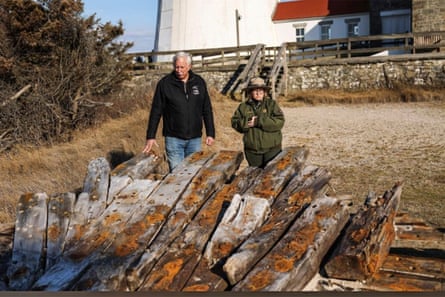‘Thrilling’ discovery on Fire Island could have come from a historic steam vessel that ran aground in 1821

An 1819 painting of the SS Savannah, by Hunter Wood. A chunk of weatherbeaten flotsam that washed up on a New York shoreline after Tropical Storm Ian last fall has piqued the interest of experts who say it is likely part of the SS Savannah. Photograph: APUS newsPiece of New York flotsam may be part of 200-year-old shipwreck SS Savannah
‘Thrilling’ discovery on Fire Island could have come from a historic steam vessel that ran aground in 1821
A chunk of flotsam that washed up on a New York shoreline after Tropical Storm Ian last year has piqued the interest of experts who say it is likely part of the SS Savannah, which ran aground and broke apart in 1821, two years after becoming the first vessel to cross the Atlantic partly under steam power.
The roughly 13ft (four-meter) square piece of wreckage was spotted in October off Fire Island, a barrier island that hugs Long Island’s southern shore, and is now in the custody of the Fire Island Lighthouse Preservation Society. It will work with National Park Service officials to identify the wreckage and put it on public display.
“It was pretty thrilling to find it,” said Betsy DeMaria, a museum technician at the park service’s Fire Island National Seashore. “We definitely are going to have some subject matter experts take a look at it and help us get a better view of what we have here.”
Evidence includes the wooden pegs holding the wreckage’s planks together, consistent with a 100ft (30.5-meter) vessel, park service officials said in a news release. The Savannah was 98ft 6 in (30 meters) long. Additionally, the officials said, the wreckage’s iron spikes suggest a ship built around 1820. The Savannah was built in 1818.
It may be difficult to identify the wreckage with 100% certainty, but park service officials said the Savannah is a top contender among Fire Island’s known shipwrecks.
Explorers have searched for the Savannah for over two centuries but have not found anything they could definitively link to the famous ship. The newly discovered wreckage, though, “very well could be” a piece of the historic shipwreck, said Ira Breskin, a senior lecturer at the State University of New York Maritime College in the Bronx. “It makes perfect sense.”

f steam power was so advanced for its time that the start of its transatlantic voyage – on 24 May 1819 – is commemorated as National Maritime Day. “It’s important because they were trying to basically show the viability of a steam engine to make it across the pond,” he said.
Breskin said a nautical archaeologist should be able to help identify the wreckage. “It’s plausible, and it’s important, and it’s living history if the scientists confirm that it is what we think it is,” he said.
The Savannah, a sailing ship outfitted with a 90-horsepower steam engine, traveled mainly under sail across the Atlantic, using steam power for 80 hours of the nearly month-long passage to Liverpool, England.
Crowds cheered as the Savannah sailed from Liverpool to Sweden and Russia and then back to its home port of Savannah, Georgia, but the ship was not a financial success, in part because people were afraid to travel on the hybrid vessel. The Savannah’s steam engine was removed and sold after the ship’s owners suffered losses in the Great Savannah Fire of 1820.
The Savannah was transporting cargo between Savannah and New York when it ran aground off Fire Island. It later broke apart. The crew made it safely to shore and the cargo of cotton was salvaged, but the Augusta Chronicle & Georgia Gazette reported that “Captain Holdridge was considerably hurt by being upset in the boat.”
You’ve read in the last year7 articlesArticle count
… as 2023 gathers pace, and you’re joining us from Vietnam, we have a small favour to ask. A new year means new opportunities, and we’re hoping this year gives rise to some much-needed stability and progress. Whatever happens, the Guardian will be there, providing clarity and fearless, independent reporting from around the world, 24/7.
Times are tough, and we know not everyone is in a position to pay for news. But as we’re reader-funded, we rely on the ongoing generosity of those who can afford it. This vital support means millions can continue to read reliable reporting on the events shaping our world. Will you invest in the Guardian this year?
Unlike many others, we have no billionaire owner, meaning we can fearlessly chase the truth and report it with integrity. 2023 will be no different; we will work with trademark determination and passion to bring you journalism that’s always free from commercial or political interference. No one edits our editor or diverts our attention from what’s most important.
With your support, we’ll continue to keep Guardian journalism open and free for everyone to read. When access to information is made equal, greater numbers of people can understand global events and their impact on people and communities. Together, we can demand better from the powerful and fight for democracy.
Whether you give a little or a lot, your funding is vital in powering our reporting for years to come. If you can, please support us on a monthly basis from just $2. It takes less than a minute to set up, and you can rest assured that you’re making a big impact every single month in support of open, independent journalism. Thank you.
Source: theguardian.com








